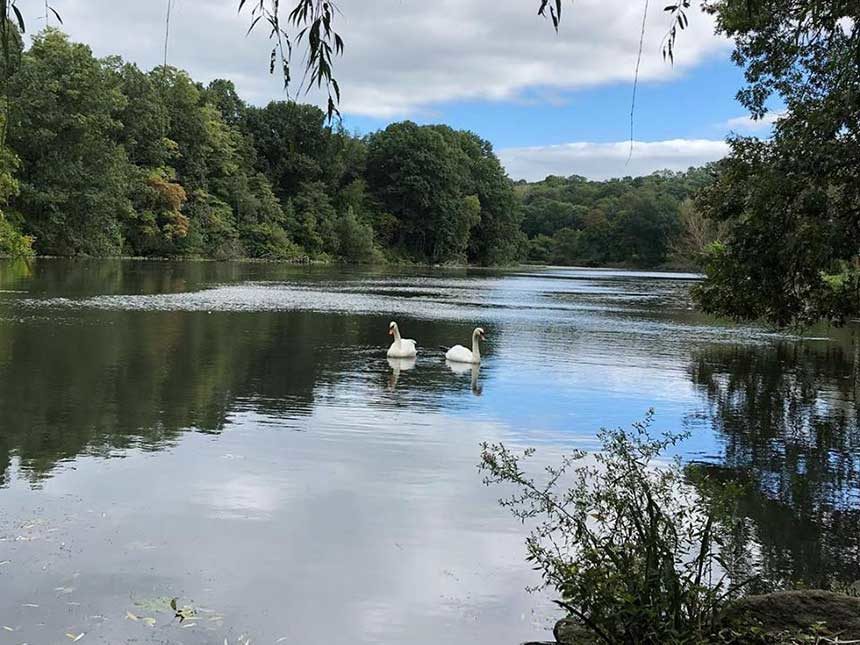Note from the ED: Sara Kempton, Director of the Programs for the Friends, is the biggest fan of swans on the Friends’ staff while the others are really not because of the ecological impact of these non-native birds. Therefore, we decided that she should be the one to write a blogpost about the impact of swans to see if she would change her opinion. Here’s what she found…
Written by: Sara Kempton
I have many fond memories of walks beside the lake with my family as a child. Of spending the day outside in Van Cortlandt Park enjoying nature and the wildlife we grew accustomed to. A highlight was always the ducks and swans in the lake. As far as I can remember Van Cortlandt Lake has had a pair of swans in it and each year we would wait for a glimpse of babies and watch as they grew up and flew away. Never did I question if these magnificent white birds belonged here, never did I question how they affected the rest of the lake or the animals and plants in it.
Fast forward some years.
Mute swans (Cygnus olor) are a non-native invasive water bird introduced to North America during the late 1800’s from their native ranges in Europe. Meant to grace private ponds and delight humans they were released from breeding locations into the wild and, finding suitable habitat in NYS, did what non-native species do and established themselves.
The introduction of a species into an ecosystem is of great concern as it often affects everything else in that ecosystem which has already developed natural checks and balances on population size and range, and organisms have established niches and roles. Mute swans never existed wild in North American waterbodies before and now these habitats must adjust, and it doesn’t always bode well for the native plants and animals.
The newly introduced mute swans are the largest water bird within the US, weighing 20-25 lbs with a wing span that can reach 7 feet. They live in waterbodies such as lakes, ponds, or marshes and have been shown to form a flock when given proper conditions (suitable space, food and other conditions that lend themselves to supporting a larger population) but are found as breeding pairs many times. In fact, they tend to be territorial and will chase away additional birds from their lake or pond if conditions don’t favor multiple pairs. This was apparent late this fall when a class on a hike through the park spent time watching a pair of mute swans puff their wings up and chase a third swan away every time it tried to enter the water. Aggressive behavior is heightened during breeding season and can be directed towards other water fowl as well as humans.
As such large birds they eat 4-8 lbs of submerged aquatic vegetation per day. Sometimes they will uproot entire plants, pulling more then they will eat. This can have detrimental effects on a waterbody, especially where larger flocks of swans are present. First, they are not the only birds that eat these aquatic plants. They directly compete with, and can outcompete, other native birds for food. Second, submerged aquatic plants play host to myriad other organisms. Fish, as well as insects, crustaceans, and other macroinvertebrates use these plants as food, shelter, or breeding areas. Swans have the potential to eliminate or dramatically decrease these habitat areas within a lake thereby affecting the abundance and variety of other organisms. Loss of organisms that depend on the now eaten plants will in turn affect the organisms that depend on them for food, and so the entire food web changes. Some organisms adapt, others can not and perish or must leave that area if they can.
The initial 500 birds released in 1910/12, soared to one point to over 2,800 and is currently around 2,200 statewide. Long Island and the lower Hudson Valley region by far have the highest populations within the state. Aside from a booming population their range has also been seen to expand dramatically between the 1980’s and early 2000’s according to DEC studies. Lake Ontario, for example, is now seeing a large mute swan population. Population predictions show likely increasing populations in areas like Lake Ontario (LI and lower Hudson Valley numbers seem to have steadied) as well as the potential for a wide increase in range as there remain many suitable habitats within the state that as of yet do not house mute swans.
So what can be done? The NYSDEC released its 3rd Draft Management Plan for mute swans within NYS in September 2017. This plan accepts that there are established feral swans within the state and at the same time strives to prevent further range expansion and population growth so as protect habitat.
Van Cortlandt Lake is not going to lose its swans any time soon, unless of course they up and fly away. As there tends to only be one pair at any given time within the lake (third wheels are swiftly made unwelcome) their effects on the lake vegetation are likely minimal. Aggressive behavior towards other water birds and humans are sometimes observed. It appears that swans have been a part of the lake for so long that the ecosystem has adjusted and reached a new balance. Perhaps a study into a pre and post swan Van Cortlandt lake is in order so that we fully understand their effects upon the ecosystem?
The lake I experienced as a child and adult might be different then its pre-swan version, but is home to a diverse and amazing assortment of organisms. I am happy to share that lake, swans and all, with my children and hopefully my grandchildren one day and encourage you to go and enjoy it as well.
To learn more about Mute Swans please check out this great video from Avi Birds.


